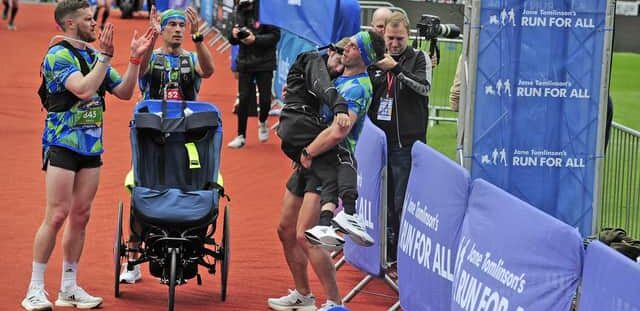[feature image: Kevin Sinfield carries Rob Burrow over the finish line of the marathon named in his honour. Picture by Steve Riding.]
In May this year former Leeds Rhinos and Great Britain Rugby League captain Kevin Sinfield ran the Leeds Marathon to raise awareness and money for a variety of Motor Neuron Disease charities. The race was the latest in a series of runs Sinfield has made; he completed the London Marathon in April and an incredible seven ultra-marathons in seven days in November 2022, raising nearly £2.5 million. Sinfield was driven to undertake the marathons by the diagnosis of his friend and teammate Rob Burrow with MND in December 2019 and his run in Leeds extended what has been a remarkable commitment by both men to further publicise and fund research into the condition. Public perception of MND has been increased considerably by Burrow’s campaign to raise nearly £7 million to build a MND care centre in Leeds and Sinfield’s runs have captured the nation’s imagination, with the dynamic of the friendship between the two men becoming central to the story.
In Leeds, Sinfield ran pushing Burrow in a wheelchair and for many observers the real interest in the race came at the very end, when he stopped to lift Burrow from the chair and carry him the last few yards over the line. It was a moment of unusual intimacy. To sustained applause and with considerable media interest, Sinfield kissed and whispered to Burrow before gently placing him back in his chair. Rugby League has strong working-class traditions in Northern England and is recognised for a physicality that sometimes verges on the brutal, and ideas of a certain kind of masculinity have always flowed from this. Burrow was known as an incredibly skilful player, while Sinfield was a hard man, as tough as any the game had produced. Even recent rethinking of relationships between men in sport couldn’t change the feeling that this moment was special, clearly an act of love between men whose careers and reputations might seem to suggest that such public display was unlikely. The BBC Sports Website contained a link to footage of the event with a single word: ‘Beautiful’.
My first reaction on seeing the footage was to look at Burrow’s body. My sister Alison died last year after three years of living with MND and, looking at Burrow in Sinfield’s arms, I saw a familiar shape – the curve of the body as a whole, the way the arms fell, the difficulty of holding up the head. I had seen all of these as Alison’s condition worsened, with each visit to her requiring a reset in thinking about what was now physically possible for her.
What I didn’t think about was a completely different reading of those final few yards. This came later when I saw a tweet by journalist and disability activist Frances Ryan. ‘I’m sure this had the best intentions as an act of friendship’ Ryan wrote, ‘but… it’s classic non-disabled gaze. A wheelchair is the dignified way to move when you can’t walk, not a horrible thing to escape. Being lifted out of it and carried makes most of us (not all!) wince at the thought’. In thinking about Burrow’s body and my personal circumstances, this point hadn’t occurred to me and – as a disability studies scholar – I immediately felt a tangible guilt because I’d missed it.
Ryan’s tweet had nearly one-and-a-half million views and many wheelchair users responded in agreement with their own stories of how their chairs made mobility, and therefore often agency and freedom, possible. These viewers saw Sinfield denying Burrow a basic dignity, highlighting dependency and not achievement. As might be expected from Twitter, non-disabled replies were critical, stressing instead Sinfield’s care and a shared achievement by the two men. Predictably, it became divisive.
Swiss athlete Marcel Hug won the wheelchair race in this year’s London marathon, using a chair that television commentators noted cost close to £40,000. This might raise eyebrows, but possibly only because of assumptions that wheelchairs shouldn’t cost this much. But Tanni Grey-Thompson, Paralympian and one of the commentators, observed that often the greatest problem for elite wheelchair athletes immediately before a race is not injury but whether their chairs survive being transported across the globe. And there’s nothing elite about finding an airline has broken your wheelchair, as many disabled travellers know. Whatever the chair, it costs time and money to replace.
It seems to me that everything raised by Sinfield’s actions in many ways epitomises the complexities raised by the interaction between disability and technology. This is maybe captured by the wider implications of Ryan’s comment ‘best intentions’; what is ‘best’ becomes almost endlessly relative in such situations, a combination of (among others) individual choice, health systems, available products, and access and cost. One person’s life-enhancing change is another’s suspicious technosolutionism. A specialist in medical rehabilitation once told me that, in terms of improving quality of life globally, the single best prosthetic is a wooden leg. Yet it is research into technologies such as brain-computer interfacing that captures the headlines
The above points of view are difficult, if not impossible, to reconcile, and the immediate reaction to Sinfield and Burrow’s marathon finish made this very clear, but it was noticeable that the missing part in the post-race discussion was Burrow’s own comment on the event. “It felt fantastic to be part of a team again with my mate Kevin as our captain” he said a few days afterwards. “Kevin joked that he didn’t want me to beat him by crossing the line (in my chair) first. I think he knew I had a cunning plan to claim that I finished before him”. He added ‘“Kevin whispered, ‘You’re not going to beat me, Rob, we are finishing together’. He then kissed me on the cheek. It was a day in a million. It felt like scoring in a Grand Final again”.

